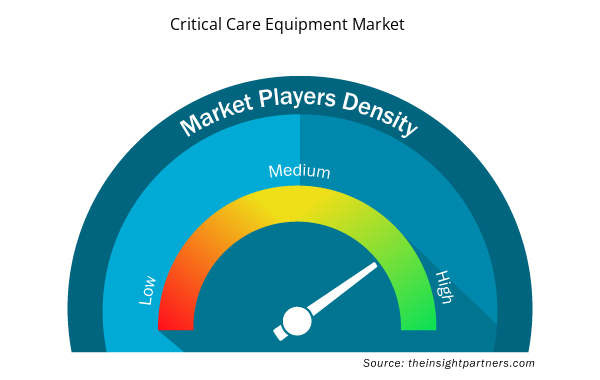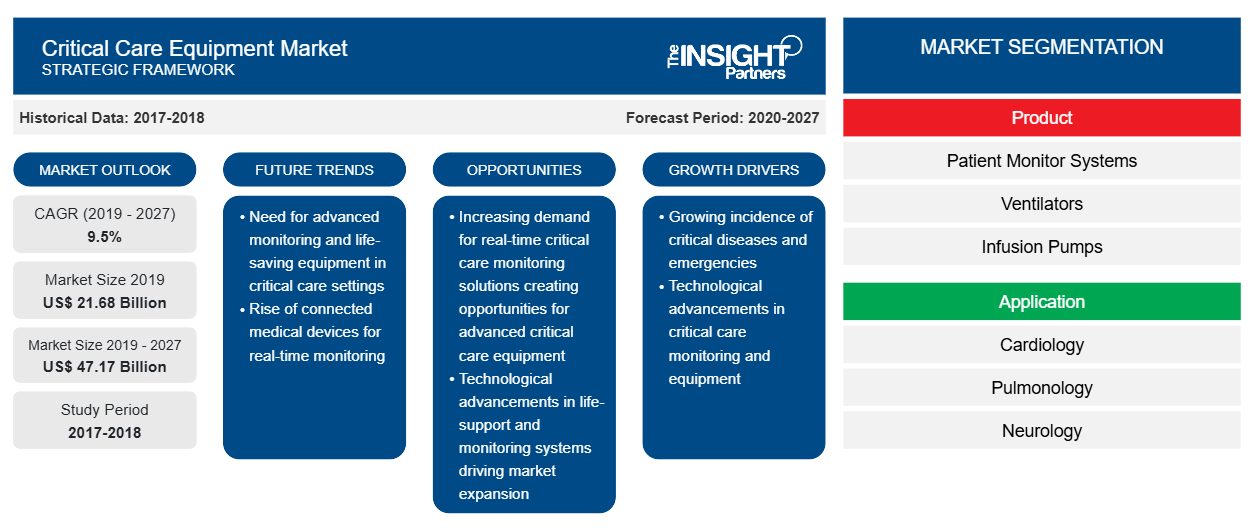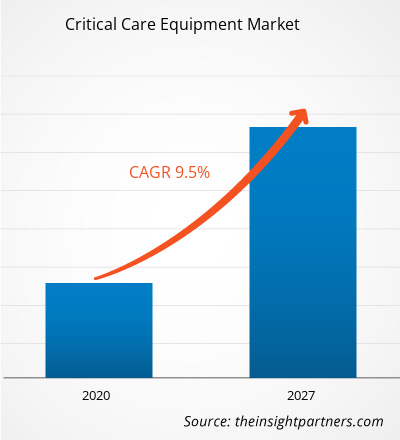救命医療機器市場は2019年に216億8,265万米ドルと評価され、2027年までに471億7,142万米ドルに達すると予測されており、2020年から2027年にかけて9.5%のCAGRで成長すると予想されています。
感染患者は平均15日間を集中治療室で過ごしている。欧州麻酔学会によると、イタリアの集中治療室のベッド数は増え続けている。ロンバルディア州では、コロナウイルス感染拡大前は民間の集中治療室のベッドが140床、公立の集中治療室(ICU)のベッドが500床あったが、2020年3月末までに900床以上に増加した。
要件に合わせてレポートをカスタマイズする
このレポートの一部、国レベルの分析、Excelデータパックなど、あらゆるレポートを無料でカスタマイズできます。また、スタートアップや大学向けのお得なオファーや割引もご利用いただけます。
- このレポートの主要な市場動向を入手してください。この無料サンプルには、市場動向から見積もりや予測に至るまでのデータ分析が含まれます。
市場分析
COVID-19の蔓延率が高い国でのICUベッド数の増加が市場の成長を牽引
COVID-19は、2020年3月11日に世界保健機関によって世界的パンデミックと宣言されました。この新しい病気は、初期の症例数が少ないものの、その後さまざまな国で感染が爆発的に増加したことが特徴です。COVID -19の拡散を抑えるためにロックダウンが実施されているにもかかわらず、さまざまな国の医療システムは、重症患者を治療するためのICUベッドやサポート機器などの機器の需要に圧倒されています。
製品インサイト
製品別では、患者モニターシステム部門が2019年に最大の市場シェアを占め、予測期間中も引き続き主要シェアを維持すると予想されています。ただし、人工呼吸器部門は予測期間中に市場でより高いCAGRを記録すると予想されています。
アプリケーションインサイト
アプリケーションに基づいて、世界の救命救急機器市場は、心臓病学、呼吸器学、神経学、整形外科、その他に分類されています。心臓病学セグメントは2019年に市場で最大のシェアを占め、呼吸器学セグメントは予測期間中に最高のCAGRを記録すると予想されています。心血管集中治療は、血管疾患や心臓病を含む重度の心血管疾患(CVD)の患者の全身管理です。CVDは世界中で死亡原因の上位にランクされています。たとえば、世界保健機関によると、2016年には推定1,790万人がCVDで亡くなり、これは世界中の死亡者の31%を占めています。同様に、疾病管理予防センターによると、毎年約655,000人のアメリカ人が心臓病で亡くなっています。CVDによる死亡を防ぐために、重度のCVD患者のための集中治療室、すなわち心血管集中治療室(CICU)が総合病院で利用できます。冠動脈内介入処置やデバイス、侵襲的血行動態モニタリングなどの臨床心臓学の技術開発は、CVD の集中治療の大きな進歩です。その結果、CICU に入院する重度の CVD 患者の数は毎年増加しています。CICU の患者は、呼吸不全や腎不全などの多くの合併症を抱えています。そのため、全身集中治療を実施するには、訓練を受けた医療スタッフが必要です。
需要と供給のギャップを埋めるために救命医療機器市場のプレーヤーが協力し、技術提携を行うことは、予測期間中の市場の成長に重要な役割を果たすと予想されます。
救命医療機器市場の地域別分析
予測期間を通じて救命医療機器市場に影響を与える地域的な傾向と要因は、Insight Partners のアナリストによって徹底的に説明されています。このセクションでは、北米、ヨーロッパ、アジア太平洋、中東、アフリカ、南米、中米にわたる救命医療機器市場のセグメントと地域についても説明します。

- 救命医療機器市場の地域別データを入手
救命医療機器市場レポートの範囲
| レポート属性 | 詳細 |
|---|---|
| 2019年の市場規模 | 216.8億米ドル |
| 2027年までの市場規模 | 471億7千万米ドル |
| 世界のCAGR(2019年 - 2027年) | 9.5% |
| 履歴データ | 2017-2018 |
| 予測期間 | 2020-2027 |
| 対象セグメント | 製品別
|
| 対象地域と国 | 北米
|
| 市場リーダーと主要企業プロフィール |
|
救命医療機器市場のプレーヤー密度:ビジネスダイナミクスへの影響を理解する
救命医療機器市場は、消費者の嗜好の変化、技術の進歩、製品の利点に対する認識の高まりなどの要因により、エンドユーザーの需要が高まり、急速に成長しています。需要が高まるにつれて、企業は提供品を拡大し、消費者のニーズを満たすために革新し、新たなトレンドを活用し、市場の成長をさらに促進しています。
市場プレーヤー密度とは、特定の市場または業界内で活動している企業または会社の分布を指します。これは、特定の市場スペースに、その規模または総市場価値と比較して、どれだけの競合相手 (市場プレーヤー) が存在するかを示します。
救命医療機器市場で事業を展開している主要企業は次のとおりです。
- ゼネラル・エレクトリック・カンパニー
- メドトロニック
- B.ブラウンメルズンゲンAG
- バクスターインターナショナル株式会社
- フィリップスNV
免責事項:上記の企業は、特定の順序でランク付けされていません。

- 救命医療機器市場のトップキープレーヤーの概要を入手
製品別
- 患者モニターシステム
- 人工呼吸器
- 侵襲的人工呼吸器
- 非侵襲性人工呼吸器
- 輸液ポンプ
- その他
アプリケーション別
- 心臓病学
- 呼吸器科
- 神経学
- 整形外科
- その他
エンドユーザー別
- 病院
- 外来診療センター
- ホームケア
- その他
地理別
- 北米
- 私たち
- カナダ
- メキシコ
- ヨーロッパ
- フランス
- ドイツ
- イタリア
- 英国
- ロシア
- アジア太平洋(APAC)
- 中国
- インド
- 韓国
- 日本
- オーストラリア
- 中東・アフリカ(MEA)
- 南アフリカ
- サウジアラビア
- アラブ首長国連邦
- 南米と中米(詐欺)
- ブラジル
- アルゼンチン
企業プロフィール
- ゼネラル・エレクトリック・カンパニー
- メドトロニック
- B.ブラウンメルズンゲンAG
- バクスターインターナショナル株式会社
- フィリップスNV
- ゲティンゲAB
- ハミルトンメディカル
- ローウェンシュタインメディカルUK社
- ドラガーヴェルクAG&Co.KGaA
- 日本光電株式会社
- フィッシャー&パイケルヘルスケアリミテッド。
- 深センミンレイバイオメディカルエレクトロニクス株式会社
- ビーピーエル
- トリビトロンヘルスケア
- スカンレイテクノロジーズ株式会社
- 旭化成株式会社
- 過去2年間の分析、基準年、CAGRによる予測(7年間)
- PEST分析とSWOT分析
- 市場規模価値/数量 - 世界、地域、国
- 業界と競争環境
- Excel データセット


- Sandwich Panel Market
- Adaptive Traffic Control System Market
- Vision Guided Robotics Software Market
- Nitrogenous Fertilizer Market
- Artificial Turf Market
- Electronic Health Record Market
- Pressure Vessel Composite Materials Market
- Underwater Connector Market
- Formwork System Market
- Transdermal Drug Delivery System Market

Report Coverage
Revenue forecast, Company Analysis, Industry landscape, Growth factors, and Trends

Segment Covered
This text is related
to segments covered.

Regional Scope
North America, Europe, Asia Pacific, Middle East & Africa, South & Central America

Country Scope
This text is related
to country scope.
よくある質問
The disruption of supply chain and logistics due to the rapid spread of COVID-19 is the significant factor that will hinder the critical care equipment market growth.
The global critical care equipment market is being driven by factors such growing number of ICU beds in countries with a high prevalence of COVID-19 and increasing demand for ventilators for the effective management of critical COVID-19 patients. Furthermore, technological innovations in critical care equipment is likely to offer significant opportunities for the growth of the global critical care equipment market.
Critical care equipment includes cardiac support, patient monitoring, respiratory support, emergency resuscitation devices, pain management, and other life support equipment designed to care for critically ill patients or have undergone a major surgical procedure, thereby requiring 24-hour care monitoring.
Trends and growth analysis reports related to Life Sciences : READ MORE..
The List of Companies - Critical Care Equipment Market
- General Electric Company
- Medtronic
- B. Braun Melsungen AG
- Baxter International Inc.
- Koninklijke Philips N.V.
- Getinge AB
- Hamilton Medical
- Löwenstein Medical UK Ltd.
- Dragerwerk AG & Co. KGaA
- Nihon Kohden Corporation
- Fisher & Paykel Healthcare Limited.
- Shenzhen Mindray Biomedical Electronics Co., Ltd.
- BPL
- Trivitron Healthcare
- Skanray Technologies Pvt Ltd
- Asahi Kasei Corporation
The Insight Partners performs research in 4 major stages: Data Collection & Secondary Research, Primary Research, Data Analysis and Data Triangulation & Final Review.
- Data Collection and Secondary Research:
As a market research and consulting firm operating from a decade, we have published and advised several client across the globe. First step for any study will start with an assessment of currently available data and insights from existing reports. Further, historical and current market information is collected from Investor Presentations, Annual Reports, SEC Filings, etc., and other information related to company’s performance and market positioning are gathered from Paid Databases (Factiva, Hoovers, and Reuters) and various other publications available in public domain.
Several associations trade associates, technical forums, institutes, societies and organization are accessed to gain technical as well as market related insights through their publications such as research papers, blogs and press releases related to the studies are referred to get cues about the market. Further, white papers, journals, magazines, and other news articles published in last 3 years are scrutinized and analyzed to understand the current market trends.
- Primary Research:
The primarily interview analysis comprise of data obtained from industry participants interview and answers to survey questions gathered by in-house primary team.
For primary research, interviews are conducted with industry experts/CEOs/Marketing Managers/VPs/Subject Matter Experts from both demand and supply side to get a 360-degree view of the market. The primary team conducts several interviews based on the complexity of the markets to understand the various market trends and dynamics which makes research more credible and precise.
A typical research interview fulfils the following functions:
- Provides first-hand information on the market size, market trends, growth trends, competitive landscape, and outlook
- Validates and strengthens in-house secondary research findings
- Develops the analysis team’s expertise and market understanding
Primary research involves email interactions and telephone interviews for each market, category, segment, and sub-segment across geographies. The participants who typically take part in such a process include, but are not limited to:
- Industry participants: VPs, business development managers, market intelligence managers and national sales managers
- Outside experts: Valuation experts, research analysts and key opinion leaders specializing in the electronics and semiconductor industry.
Below is the breakup of our primary respondents by company, designation, and region:

Once we receive the confirmation from primary research sources or primary respondents, we finalize the base year market estimation and forecast the data as per the macroeconomic and microeconomic factors assessed during data collection.
- Data Analysis:
Once data is validated through both secondary as well as primary respondents, we finalize the market estimations by hypothesis formulation and factor analysis at regional and country level.
- Macro-Economic Factor Analysis:
We analyse macroeconomic indicators such the gross domestic product (GDP), increase in the demand for goods and services across industries, technological advancement, regional economic growth, governmental policies, the influence of COVID-19, PEST analysis, and other aspects. This analysis aids in setting benchmarks for various nations/regions and approximating market splits. Additionally, the general trend of the aforementioned components aid in determining the market's development possibilities.
- Country Level Data:
Various factors that are especially aligned to the country are taken into account to determine the market size for a certain area and country, including the presence of vendors, such as headquarters and offices, the country's GDP, demand patterns, and industry growth. To comprehend the market dynamics for the nation, a number of growth variables, inhibitors, application areas, and current market trends are researched. The aforementioned elements aid in determining the country's overall market's growth potential.
- Company Profile:
The “Table of Contents” is formulated by listing and analyzing more than 25 - 30 companies operating in the market ecosystem across geographies. However, we profile only 10 companies as a standard practice in our syndicate reports. These 10 companies comprise leading, emerging, and regional players. Nonetheless, our analysis is not restricted to the 10 listed companies, we also analyze other companies present in the market to develop a holistic view and understand the prevailing trends. The “Company Profiles” section in the report covers key facts, business description, products & services, financial information, SWOT analysis, and key developments. The financial information presented is extracted from the annual reports and official documents of the publicly listed companies. Upon collecting the information for the sections of respective companies, we verify them via various primary sources and then compile the data in respective company profiles. The company level information helps us in deriving the base number as well as in forecasting the market size.
- Developing Base Number:
Aggregation of sales statistics (2020-2022) and macro-economic factor, and other secondary and primary research insights are utilized to arrive at base number and related market shares for 2022. The data gaps are identified in this step and relevant market data is analyzed, collected from paid primary interviews or databases. On finalizing the base year market size, forecasts are developed on the basis of macro-economic, industry and market growth factors and company level analysis.
- Data Triangulation and Final Review:
The market findings and base year market size calculations are validated from supply as well as demand side. Demand side validations are based on macro-economic factor analysis and benchmarks for respective regions and countries. In case of supply side validations, revenues of major companies are estimated (in case not available) based on industry benchmark, approximate number of employees, product portfolio, and primary interviews revenues are gathered. Further revenue from target product/service segment is assessed to avoid overshooting of market statistics. In case of heavy deviations between supply and demand side values, all thes steps are repeated to achieve synchronization.
We follow an iterative model, wherein we share our research findings with Subject Matter Experts (SME’s) and Key Opinion Leaders (KOLs) until consensus view of the market is not formulated – this model negates any drastic deviation in the opinions of experts. Only validated and universally acceptable research findings are quoted in our reports.
We have important check points that we use to validate our research findings – which we call – data triangulation, where we validate the information, we generate from secondary sources with primary interviews and then we re-validate with our internal data bases and Subject matter experts. This comprehensive model enables us to deliver high quality, reliable data in shortest possible time.


 このレポートの無料サンプルを入手する
このレポートの無料サンプルを入手する